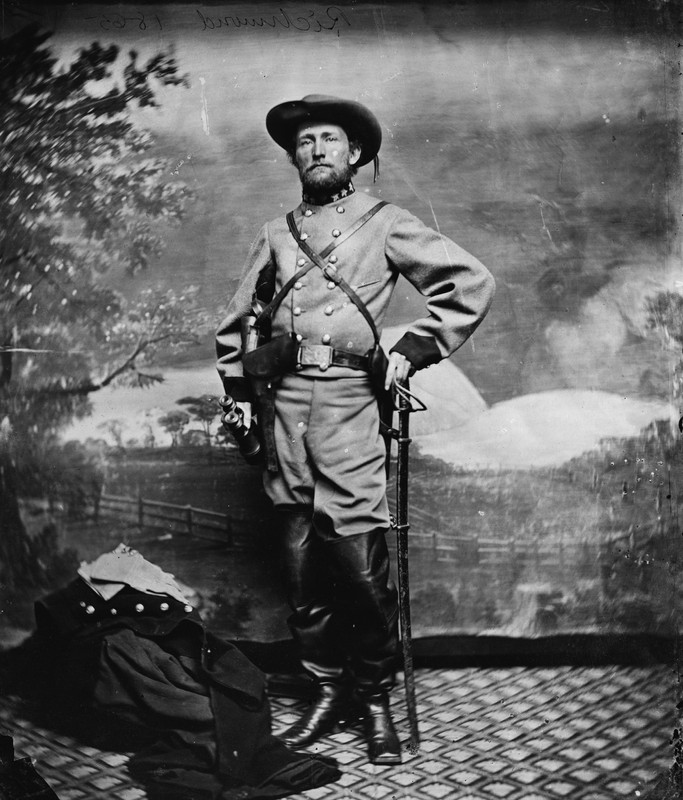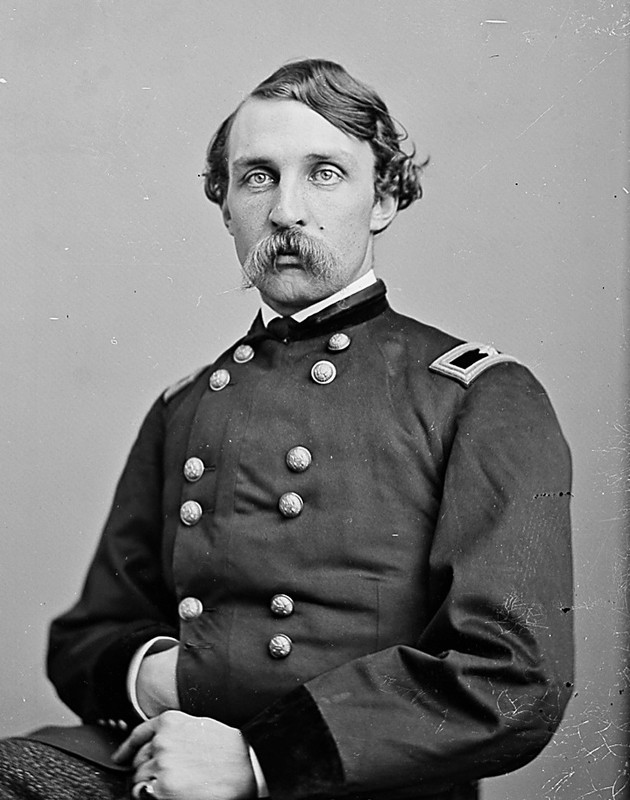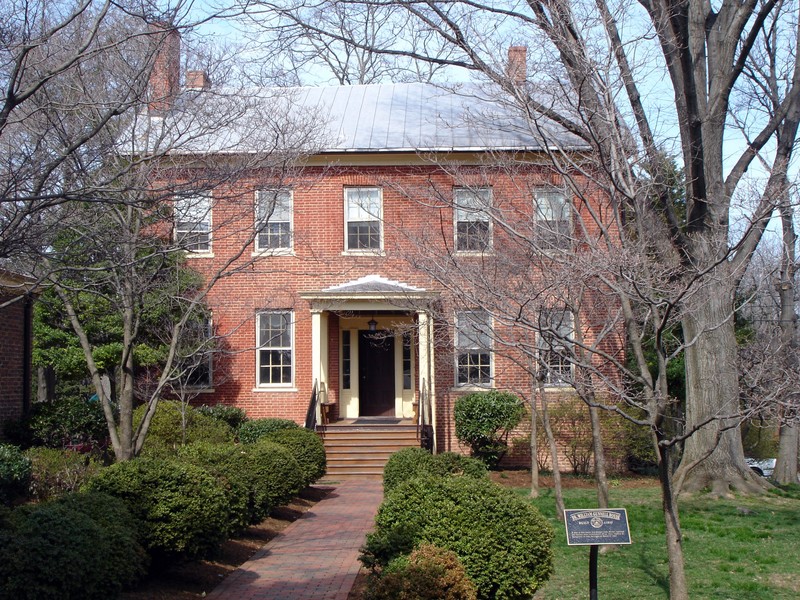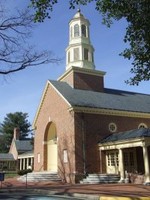Home of Dr. William P. Gunnell and "Gray Ghost's Coup" of 1863
Introduction
Text-to-speech Audio
Images
Colonel John S. Mosby

General Edwin Stoughton

The Dr. Gunnell House - now an administrative office for the adjacent church

Truro Anglican Church - located next to the Dr. Gunnell House

Backstory and Context
Text-to-speech Audio
The Dr. William Presley Gunnell Home is a Southern Colonial-style house built around 1835. Dr. Gunnell owned it by 1860. He was born in Fairfax County around 1820 and was a graduate of the University of Pennsylvania. Initially impressed into service as a Union surgeon, he escaped and joined the Confederate army.
On the night of March 8th-9th, 1863, twenty-nine Confederate soldiers led by John Singleton Mosby made their way through Union lines to raid Fairfax. Although a small contingent of Union soldiers had been monitoring the perimeter around the town, there were no Confederate armies in the immediate area and the region was thought secure. Brigadier General Edwin Stoughton, who had set up his headquarters in the Dr. Gunnell House, had not assigned any of his men to guard the property overnight. It is also reported that the Union officers had been partying that evening. This made it possible for Mosby and his men to make their way through Union lines undetected; the entire contingent of Union soldiers was caught by surprise. Mosby, claiming to be from the 5th New York Cavalry, made his way into the Dr. Gunnell House and forced a staff officer to bring him to Stoughton's bedroom. Mosby slapped Stoughton on the back to wake him up. Several versions of the following conversation have been reported, even by Mosby himself. The most famous, written by Mosby in Belford's Monthly, is that he asked, "General, did you ever hear of Mosby?” Stoughton answered, "Yes, have you caught him?" Mosby responded, "No. I am Mosby - he has caught you."[6] Mosby included a different version in his memoirs: "[Stoughton] asked in an indignant tone what all this meant. I told him that he was a prisoner, and that he must get up quickly and dress. I then asked him if he had ever heard of 'Mosby', and he said he had. 'I am Mosby,' I said. 'Stuart's cavalry has possession of the Court House; be quick and dress.'"[5] Mosby not only captured Stoughton, but also two Union captains, thirty men, and fifty-eight horses, before he and his band returned to Confederate lines. Stoughton was disgraced; after he was released, he never commanded again and ultimately died in 1868 at age thirty. Abraham Lincoln was said to have remarked that, "he didn't mind the loss of the brigadier as much as the horses, for I can make a much better general in five minutes, but the horses cost one hundred and twenty-five dollars a piece."[4] Supposedly, Confederate spy and Fairfax resident Antonia Ford was involved in planning the raid - a Secret Service investigation resulted in her arrest. While Mosby himself later denied her connection, he may have done this for political reasons. She was held in a federal prison for several months, afterwards marrying Union Major Joseph Willard, the officer who had arrested her.
After the war, Dr. Gunnell eventually moved to Waco, Texas, where he continued practicing medicine until his death in 1875. His Fairfax home was bought by Zion Episicopal Church, now Truro Anglican Church, in 1882 for use as a rectory; it is still used as an office by the church today. The house was added to the National Register of Historic Places as part of the City of Fairfax Historic District in 1987.
Sources
1) Beard, Rick. Mosby’s Sneak Attack, The New York Times: Opinionator. March 8th 2013. Accessed June 30th 2020. https://opinionator.blogs.nytimes.com/2013/03/08/mosbys-sneak-attack/?searchResultPosition=1.
2) Coski, Ruth Ann. John Singleton Mosby (1833–1916), Encyclopedia Virginia: Virginia Humanities. March 1st 2014. Accessed June 30th 2020. https://www.encyclopediavirginia.org/mosby_john_singleton_1833-1916.
3) John Singleton Mosby; Biographies; Learn, American Battlefield Trust. Accessed June 29th 2020. https://www.battlefields.org/learn/biographies/john-singleton-mosby.
4) Malanowski, Jamie. The Underappreciated and Forgotten Sites of the Civil War: Fairfax, Virginia (2 of 15), Smithsonian Magazine. April 1st 2015. Accessed June 29th 2020. https://www.smithsonianmag.com/history/underappreciated-forgotten-sites-civil-war-180954579/?page=2.
5) Mosby, John Singleton. Russell, Charles Wells. The Memoirs of Colonel John S. Mosby. Boston, MA. Little, Brown, and Company, 1917. University of North Carolina at Chapel Hill: Documenting the American South. 1998. Accessed June 30th 2020. https://docsouth.unc.edu/fpn/mosby/mosby.html.
6) Mosby, John S. One of My War Adventures. Belford's Monthly. Volume 9 (June-November 1932). pp. 122 - 132. Google Books. November 21st 2007. Accessed June 30th 2020. https://books.google.com/books?id=PMURAAAAYAAJ.
7) Ryan, Terri Jo. Waco physician’s former Virginia home has storied past, Waco Tribune-Herald. July 20th 2013. Accessed June 30th 2020. https://www.wacotrib.com/news/local/waco-physician-s-former-virginia-home-has-storied-past/article_3e2d09f8-0054-55ef-8485-5bfe993574b5.html.
8) Saxe, Emma Jane. City of Fairfax Historic District, National Register of Historic Places Inventory/Nomination Form, Virginia Division of Historic Landmarks (now Virginia Department of Historic Resources). October 27th 1987. Accessed June 30th 2020. https://www.dhr.virginia.gov/VLR_to_transfer/PDFNoms/151-0003_CityofFairfax_HD_1987_Final_Nomination.pdf.
9) Whitehead, Ashley M.. Antonia Ford (1838–1871), Encyclopedia Virginia: Virginia Humanities. May 27th 2014. Accessed June 30th 2020. https://www.encyclopediavirginia.org/Ford_Antonia_1838-1871.
Public Domain - Wikimedia Commons (https://commons.wikimedia.org/wiki/File:John_S._Mosby_-_Brady-Handy.jpg)
Public Domain - Wikimedia Commons (https://commons.wikimedia.org/wiki/File:Gen._Edwin_Henry_Stoughton.jpg)
On HMdb.org (https://www.hmdb.org/PhotoFullSize.asp?PhotoID=18641)
Public Domain - Wikipedia (https://en.wikipedia.org/wiki/File:Truro_Church.jpg)
